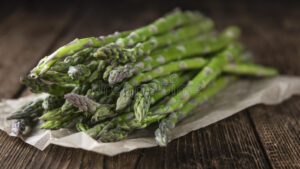Spring —Now is the right time. If there is one reason to eat asparagus, there might be a dozen.
The flavor of asparagus is elusive to describe. Is it buttery or herbal, mellow or nutty, or delicious and surprising? Maybe all of these! The delicate taste of asparagus has a flavor like none other.
But that is only part of the story – its intriguing-shaped tip (sometimes purple) leading to a lighter green stalk is stylistically beautiful served whole beside a grilled chicken breast or piece of lasagna, or as part of a “salade composé.” Paired with lemon or crab and pasta, these super spears sparkle.
And speaking of super spears, according to the National Cancer Institute, asparagus is the highest-tested food containing glutathione, one of the body’s most potent cancer fighters. Additionally, asparagus is high in rutin, which is valuable in strengthening blood vessels.
Charles Lamb, the English essayist, wrote, “Asparagus inspires gentle thoughts.” My guess it that Lamb might have been describing white asparagus. It seems to be the color choice of asparagus in Europe. Everywhere we traveled in Germany a few years ago, whether restaurants, farm stands, grocery stores, department store restaurants, delis, neighborhood bars, even autobahn luncheonettes, all proudly displayed signs detailing “Spargel” specials. https://germanfoods.org/german-food-facts/spargelzeit-asparagus-season-in-germany/
Getting through a German menu became much easier once we understood that spargel was white asparagus. For me to say that white asparagus is mild in flavor is saying too much -—bland might be a better word. My delight, however, came from the appreciation, excitement and cooperation of growers, chefs and customers who partnered to publicize, prepare and partake of this once-a-year treat. White asparagus is more labor-intensive to grow than green. White asparagus is planted in rows of mounded soil and covered with black plastic, which restricts the development of chlorophyll.
Lots of controversy revolves around the size of preferred asparagus stalks. Is it better to buy thin or thick stalks? If you notice in the grocery store, one does not usually have a choice. The asparagus bundles are either thin or thick.
I think it is a matter of the season. I find the first spring crop from California with medium stems to be the very tastiest. Of course, picking locally is a fun-filled journey, and if nutrition is lost in transporting from California, Washington or Michigan, then we and our local growers win.
The beauty of spring and asparagus for me is the versatility of the foods that pair well with asparagus. Of course, first we must talk about the proper preparation and correct cooking to showcase the vegetable’s noble potential.
Roasting asparagus
The base of asparagus is woody and tough. Some chefs peel the base. One chef recently advised peeling by inserting into an electric pencil sharpener. Trust me on this one —break the base off by snapping, not cutting. Each asparagus spear has its own breaking point. I have done this for parties of 400 people. Once you get the hang of it, it really goes quite quickly.
Discard the base. Preheat oven to 450° F. Gently wash the spears. Dry. Lay in a single layer on a baking sheet. Drizzle with a scant amount of olive oil. Sprinkle with kosher salt and freshly ground pepper. Toss to combine.
Bake for 5-8 minutes. The asparagus will remain bright green with toasty brown spots (if they were dried thoroughly). Test with a fork. Tender crisp is the signal. They will cook a little more out of the oven.
Asparagus Tart with EZ Crust in the next post.
Foodly Yours,Pat


